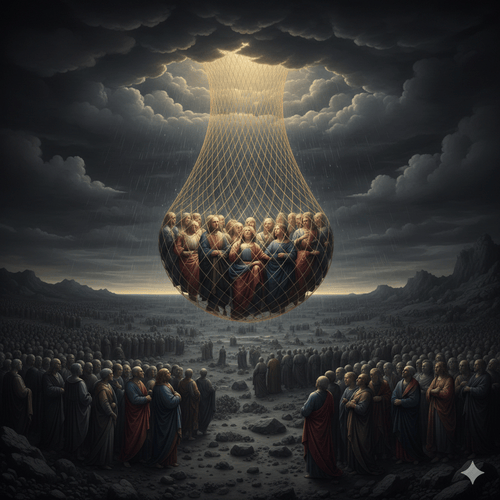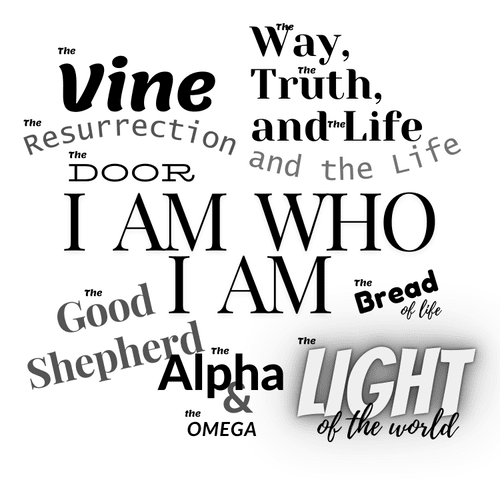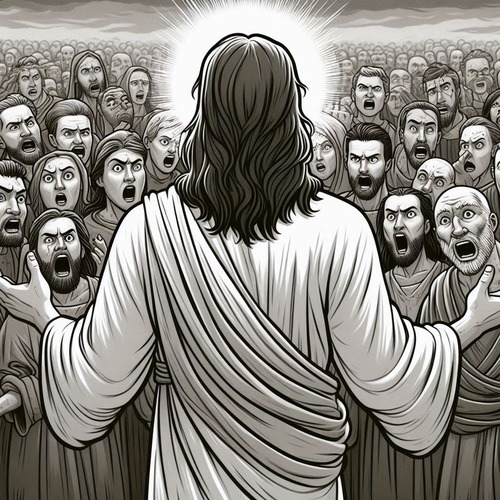Jesus’ ‘I AM’ Statements: Proclamations of Deity
The great Imagine standing before the One who breathed life into the cosmos. Now, picture Him, infinite and eternal, stepping into time and into the limitations of human flesh, to walk among us. But why? Why would the Author step into His own story? The answer lies in the unfathomable depths of divine love.
The great “I AM” who appeared to Moses in the burning bush, who led Israel through the wilderness, who spoke through the prophets, has now come in person. Not to condemn, but to save. Not to demand, but to give. The “I AM” willingly stretches out His hands to be nailed to a cross.
Jesus’ ‘I AM’ Statements: The “I AM” statements of Jesus are declarations of His divine nature, recorded exclusively in John’s Gospel and in the Book of Revelation. The other Gospels don’t have them. The statements aren’t mere assertions: they’ve been intricately woven into the fabric of John’s narrative, each accompanied by a miraculous sign to validate it. Interestingly, John’s Gospel records only seven miracles, and most of these serve to authenticate an “I AM” statement. This deliberate structure underscores the significance of these declarations in understanding Jesus’ identity and mission.
The Significance of “I AM”: When Jesus proclaims Himself to be the “I AM,” He is invoking the divine name that was revealed to Moses at the burning bush (Exodus 3:14). God identifies Himself to Moses there as “I AM WHO I AM.” It is a name that transcends time, declaring His eternal and immutable nature—He was the same yesterday, is the same today and will be forever (Hebrews 13:8). By adopting this title, Jesus is unequivocally claiming divinity. He is not just a man of God but God incarnate. The claim to be the “I AM” is the common thread in these statements, each of which reveals a different facet of His divine character and role.
The Jews’ Response: The significance of Jesus’ “I AM” declarations was not lost on His Jewish audience, who fully grasped the gravity of the claims. In John 8:58-59, when Jesus declares, “Before Abraham was, I am,” the crowd’s immediate reaction is to stone Him; this demonstrates they understood He was claiming equality with God—a claim they considered blasphemous, one punishable by death by their law.
The Power of “I AM”: The inherent power in Jesus’ “I AM” declarations is vividly illustrated in John 18:5-6. When the soldiers come to arrest Him and He identifies Himself as “I AM,” they fall backward to the ground. This supernatural demonstration of authority shows Jesus was not a helpless victim being led to the cross, but was willingly laying down His life (John 10: 17-18).
I Am the Bread of Life (John 6:35)
- Validating Miracle: Feeding of the 5,000 (John 6:1-14).
- Meaning: Jesus is the sustenance for our spiritual hunger, offering eternal satisfaction. .
- Old Testament Connection: Manna from heaven, a divine provision during the Israelites’ journey in the wilderness (Exodus 16).
- Implication: Picture a vast crowd, their stomachs full from feeding on miraculously multiplied loaves and fish—yet their souls are still hungering for something more. Into this moment, Jesus declares, “I am the bread of life.” No, He’s not offering another meal. Just as manna sustained Israel in the wilderness, Jesus promises to nourish our deepest spiritual hunger. But He goes further—this bread doesn’t just sustain life; it gives eternal life. In a world starving for meaning and purpose, Jesus offers Himself as the feast that truly satisfies.
Jesus’ ‘I AM’ Statements: I Am the Light of the World (John 8:12)
- Validating Miracle: Healing of the man born blind (John 9:1-12).
- Meaning: Jesus brings spiritual enlightenment, dispels darkness of sin and ignorance.
- Old Testament Connection: Light is a symbol of God’s presence and guidance (Psalm 27:1, Isaiah 9:2); He is a pillar of cloud by day and of fire by night (Exodus 13:21-22).
- Implication: Imagine the scene: the Feast of Tabernacles, where giant lamps illuminate the temple, reminding Israel of the pillar of fire that guided them through the desert. In this context, Jesus boldly proclaims, “I am the light of the world.” He’s not just claiming to be a teacher or guide; He’s declaring Himself to be the divine light that dispels all darkness. In a world shrouded in the shadows of sin, confusion, and despair, Jesus offers Himself as the illuminating presence that brings clarity, hope, and life. His subsequent healing of a man born blind serves as validation. He doesn’t just help us see; He gives sight to those who have never known light. On our wilderness journey, He is also our pillar of fire by night—we may go to Him each time we’re seeking direction for life.
I Am the Door (John 10:7)
- Validating Miracle: The healing of the invalid man at the Sheep Gate, near the pool of Bethesda (John 5:1-15), symbolising our once crippled state has been healed so we can move in through the door.
- Meaning: Jesus is the entry point to spiritual safety and eternal life. He is also our only access to the Father.
- Old Testament Connection: The doorways are protected by the blood of the Passover lamb, providing safety from the angel of death (Exodus 12:23). In the New Testament, the temple curtain tore asunder (Luke 23:45) with Jesus’ death on our behalf, signalling we now have access to the Holy of Holies, and to the Father, through Jesus, our Door.
- Implication: In a culture intimately familiar with shepherding, Jesus’ declaration of being “the door” would have resonated deeply. He’s not just saying He’s an entrance; He’s proclaiming Himself as the exclusive means of access to God’s fold. This statement is both inclusive and exclusive—welcoming all who would enter through Him, yet firmly asserting there is no other way. In a world of countless philosophies and religions, Jesus stands unique, offering not just one path among several to follow, but Himself as our only portal to eternal life.
Jesus’ ‘I AM’ Statements: I Am the Good Shepherd (John 10:11-14)
- Validating Miracle: In claiming to be our good Shepherd, Jesus prophesied He would prove it by laying down His life for us (John 10:11). He who is God—the deathless One—miraculously died (John 19:30) just for us, His sheep.
- Meaning: Jesus, the Good Shepherd, knows His sheep intimately, even sacrifices His life for them.
- Old Testament Connection: Psalm 23, depicting God as the shepherd who provides, guides, and protects. Also, God promised (in Ezekiel 34:11-31) He will Himself be a Shepherd to His people.
- Implication: Jesus’ relationship with His followers is personal, sacrificial. He lays down His life, demonstrating His love and commitment. Jesus isn’t just any shepherd. He is the “good” Shepherd, echoing God’s own self-description in Ezekiel 34. He is no hired hand who will run at the first sign of danger. He is our owner, our protector. He knows His sheep by name. As our good Shepherd, Jesus is claiming the divine role of caretaker for God’s people. The promised intimate, sacrificial love would find its ultimate expression on the cross.
I Am the Resurrection and the Life (John 11:25)
- Validating Miracle: Raising Lazarus from the dead (John 11:17-37).
- Meaning: Jesus has power over life and death, offering eternal life to those who believe in Him.
- Old Testament Connection: The hope of resurrection and eternal life found in the prophetic writings (Isaiah 26:19, Daniel 12:2).
- Implication: Jesus promises eternal life, not just a future resurrection but a present transformation for those who believe in Him. Standing before the tomb of Lazarus, with the stench of death heavy in the air, Jesus makes perhaps His most audacious claim yet: “I am the resurrection and the life.” He’s not just promising a future event; He’s declaring Himself to be the very power of life over death. In raising Lazarus, Jesus doesn’t just perform a miracle; He provides a preview of His own resurrection and the life He offers to all who believe. In a world gripped by the fear of death, Jesus presents Himself as the solution to our deepest existential dread—that of death.
Jesus’ ‘I AM’ Statements: I Am the Way, the Truth, and the Life (John 14:6)
- Validating Miracle: The tearing of the temple curtain from top to bottom the moment Jesus died—this miracle isn’t recorded by John but Luke (Luke 23:45)
- Meaning: Jesus is the only path to God, embodying truth and life.
- Old Testament Connection: The concept of “the way” as the path of righteousness and covenant faithfulness (Isaiah 40:3).
- Implication: “I am the way, the truth, and the life” (John 14:6) In the intimate setting of the Upper Room, with the cross looming, Jesus distils His identity into a trinitarian statement. He is not merely showing the way, speaking truth, or offering life—He embodies all three. He IS all three. His comprehensive claim leaves no room for alternatives. In a world of relative truths and multiple paths, Jesus stands as the absolute—the exclusive route to the Father, the embodiment of all truth, and the source of genuine life.
I Am the True Vine (John 15:1)
- Validating Miracle: Jesus turns water into wine (John 2:1-12)
- Meaning: Jesus is the source of spiritual vitality and fruitfulness. Just as He made new wine taste better than old at Cana, He offers to renew us.
- Old Testament Connection: Israel as the vineyard of God, often failed to produce good fruit (Isaiah 5:1-7).
- Implication: True spiritual growth and productivity come from abiding in Christ, who empowers and sustains His followers. As Jesus prepares His disciples for His departure, He gives them this beautiful metaphor of the vine. Israel had been called God’s vine, but often failed to produce fruit. Jesus declares Himself the true vine—the genuine article, the fulfillment of what Israel was meant to be. In doing so, He invites us into a relationship of utter dependence and continual nourishment. This is not a religion of rules, but a living connection to the very source of spiritual vitality.
Jesus’ ‘I AM’ Statements: I Am the Alpha and the Omega (Revelation 1:8)
- Validating Miracle: John encounters the risen and glorious Christ in Revelation 1, and is overawed by the amazing, miraculous transformation he sees in the Lord (Revelation1: 12-18).
- Meaning: Jesus is the beginning and the end, encompassing all of history. He has not only eternally existed, but has sovereign authority over time.
- Old Testament Connection: Remember God’s self-identification as the first and the last (Isaiah 44:6)?
- Implication: Finally, in John’s apocalyptic vision, we hear Jesus’ ultimate self-declaration. He is the beginning and the end, encompassing all of history, all of creation, all of existence. This statement, echoing God’s words (in Isaiah 44:6), is a resounding affirmation of Christ’s deity and His cosmic significance. The one who was born in Bethlehem and died on Calvary is the same one who spoke the universe into being and who will bring all things to their consummation.
Conclusion: As we reflect on these staggering claims, we’re confronted with a choice. These are not the words of a mere moral teacher or a misguided prophet. They are the declarations of one who claims to be the eternal God incarnate, no less.
But here’s the wonder that should bring us to our knees: this majestic, eternal “I AM” chose to become Immanuel—God with us. The infinite became infant. The Creator became creature. The Lord became servant. Why? So we might know God not as a distant deity, but as a loving Father. So we might have life, and have it abundantly.
Jesus’ ‘I AM’ Statements: The “I AM” statements are not just claims of divinity; they’re an invitation to relationship. The bread of life invites us to feast on His goodness. The light of the world beckons us out of darkness. The door welcomes us into God’s family. The good shepherd calls us to trust in His provision and care. The resurrection and the life offers us victory over death. The way, truth, and life provides the path to the Father. The true vine invites us to abide in Him for fruitfulness. And the Alpha and Omega assures us that our stories are held securely in His eternal narrative.
As we stand in awe before these declarations, may we respond not just with intellectual assent, but with wholehearted devotion. For the “I AM” who spoke galaxies into existence now speaks a word of love over us: “Come to me, all who labour and are heavy laden, and I will give you rest” (Matthew 11:28).
Related Reads:
- Jesus’ Claims to Divinity: Unveiling the Biblical Evidence
- Why do We Affirm Jesus is Fully God and Fully Man?
- Jesus’ Resurrection: Fact or Fiction?
- Stop the Search: Jesus is The Promised Messiah
Editor's Pick

Why Do People Hate the Doctrine of Election?
…WHEN THEY REALLY SHOULDN’T Few Bible doctrines provoke stronger reactions than election. The idea that God chose some for salvation [...]

The Doctrine of Providence: Does God Really Govern All Things?
You’re sitting in the doctor’s office when the diagnosis lands like a thunderclap. Your mind races: Why this? Why now? [...]

No Decay, No Defeat: What It Means That Christ’s Body Saw No Corruption
On the Day of Pentecost, Peter stood before thousands and made a startling claim: David's body decayed in the tomb, [...]
SUPPORT US:
Feel the Holy Spirit's gentle nudge to partner with us?
Donate Online:
Account Name: TRUTHS TO DIE FOR FOUNDATION
Account Number: 10243565459
Bank IFSC: IDFB0043391
Bank Name: IDFC FIRST BANK






